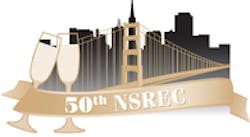50th NSREC opens, offers insight into latest radiation effects studies
SAN FRANCISCO, Calif., 9 July 2013. IEEE and NPSS Radiation Effects Committee officials kicked off the 50th Nuclear & Space Radiation Effects Conference, Short Course, and Radiation Effects Data Workshop this week in San Francisco.
The 2013 NSREC Technical Program launched this morning, with papers centered on space and terrestrial environments. Professionals from Naval Research Laboratory, Air Force Research Laboratory, AER Inc., and Harris Corp. provided a discussion of TacSat-4 and the effects of the radiation environment and solar cell degradation using onboard experiments. TacSat-4 carries the CEASE radiation spectrometer, as well as a full I-V characterization experiment on 3J solar cells. “CEASE measured much higher proton contributions than predicted,” revealed S. Huston of AER Inc.
Industry professionals packed the conference room to gain insight into the Van Allen Probes mission to study the dynamics of Earth’s Van Allen Radiation Belts. “Early Results from the Engineering Radiation Monitor (ERM) on the Van Allen Probes Mission”—a paper by specialists at The Johns Hopkins Applied Physics Laboratory and REM Oxford Ltd.—reported early findings from the ERM, which measures dose, dose rate, and charging currents. Both ERMs powered -29 hours after launch and have operated continuously. After 268 days, the electron charging current (>0.7MeV) proved to be highly variable in both time and space. Scientists found good correlation between RAFET dosimeter and charge monitor (electron-dominated) data; further, solar cell monitors are recording array degradation. In summary, at 8.9mm AI, measured dose is -4000 rads vs. NOVICE transport AP8/AE8 worst-case prediction of 5000 rads after 260 days.
Professionals were encouraged by the results of the mission, which is still considered to be in its very early stages.

